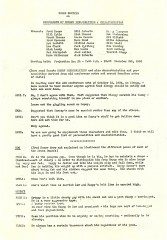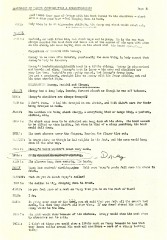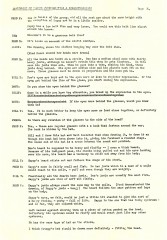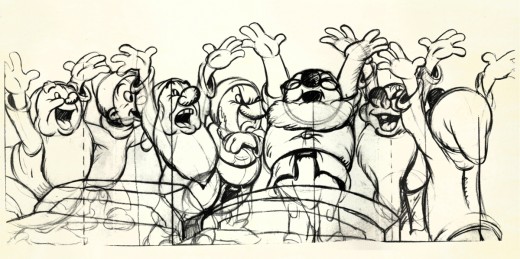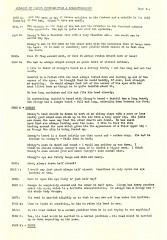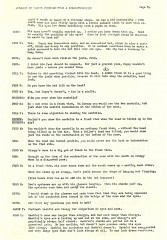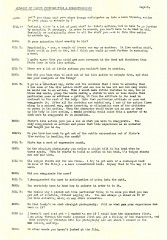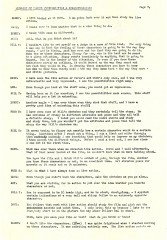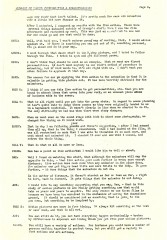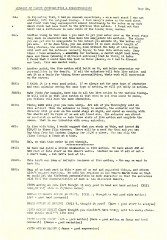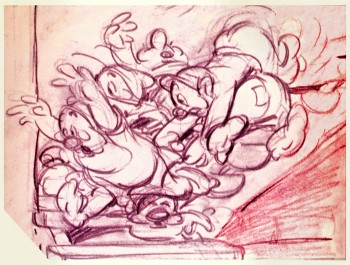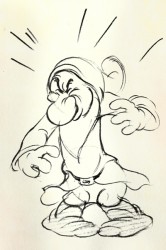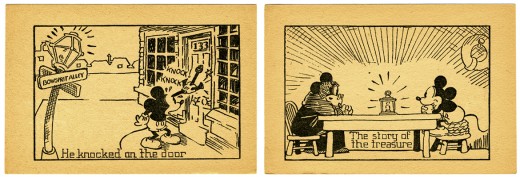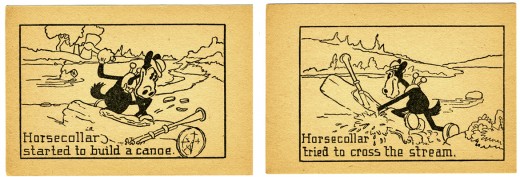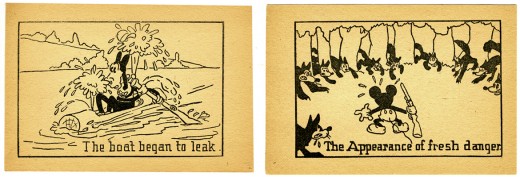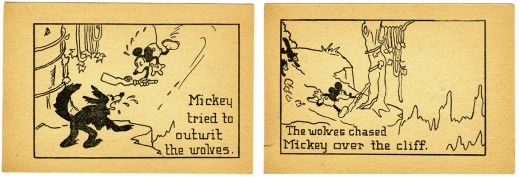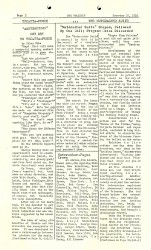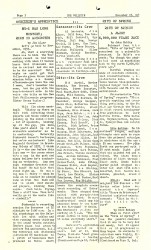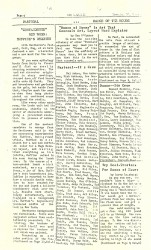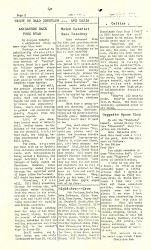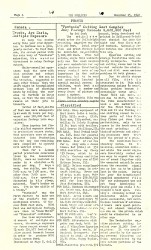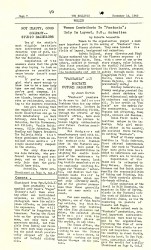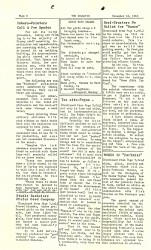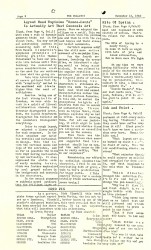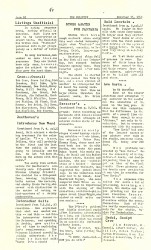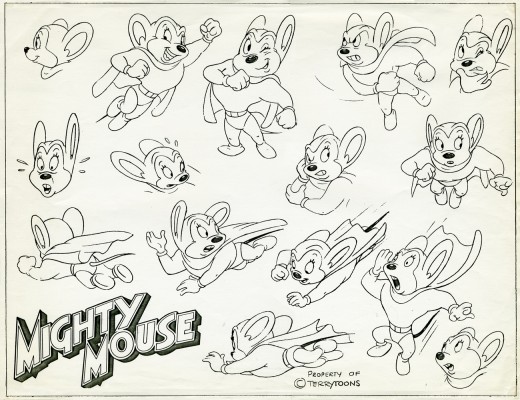Category ArchiveAnimation Artifacts
Animation Artifacts 26 Jan 2007 08:06 am
Seven “Little People”
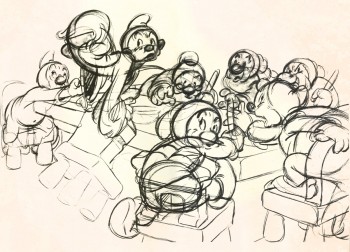 - What follows is a series of notes taken at a Disney story meeting discussing the seven dwarfs.
- What follows is a series of notes taken at a Disney story meeting discussing the seven dwarfs.
It’s obvious that this was an important meeting. All of the Gods-as-animators were in attendance and participate in the open discussion: Bill Tytla, Dick Lundy, Dave Hand, Art Babbitt, Fred Moore, Ham Luske, Les Clark, Wilfred Jackson, Frank Thomas, and Ollie Johnson. The list goes on; just look at that first page.
(Click on any image to enlarge.)
You’ll note that it goes from page 7 to page 9, but I’m pretty sure nothing is missing. There’s also a little bit of distortion on the old copier used to copy this back in the 70′s. It’s illustrated with images from a Snow White book AMEX offered years ago. I haven’t seen it anywhere else since I bought a copy.
Animation Artifacts &Daily post 16 Jan 2007 09:25 am
I Can Smile at the Old Days
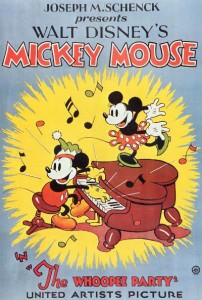 - Just to get myself in the spirit sometimes takes a bit of energy. I can sit down and start working, but I prefer to have the right frame of mind before I do anything to do with animation. This is especially and most importantly necessary when I’m doing a job for hire. I have the impetus and the motive, but the emotional framework has to be geared up and ready to go.
- Just to get myself in the spirit sometimes takes a bit of energy. I can sit down and start working, but I prefer to have the right frame of mind before I do anything to do with animation. This is especially and most importantly necessary when I’m doing a job for hire. I have the impetus and the motive, but the emotional framework has to be geared up and ready to go.
The animated shorts that make me smile most inside are the old B&W Mickey cartoons. I had a 16mm print of The Whoopee Party (1932), and I think I ran that thing a couple of hundred times for myself. I loved it. (Someday, now that I have the dvd, I’ll make a lot of frame grabs for my own amusement.)
Jungle Rhythm (1929) was another film I had that wasn’t quite as charming, but I ran it often enough. (This somehow reminded me of an early Tom and Jerry short I owned in 8mm. No, not the cat and mouse, but the short and tall guys from Van Buren cartoons.)
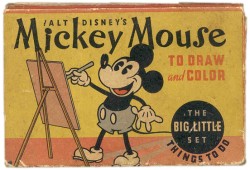 Now, if I want to get in the proper spirit, I can pull out a dvd and watch it on my tv or computer. But that somehow has a distance to it that 16mm didn’t. I like to feel the textures of the cartoons, and the dvds are too clean.
Now, if I want to get in the proper spirit, I can pull out a dvd and watch it on my tv or computer. But that somehow has a distance to it that 16mm didn’t. I like to feel the textures of the cartoons, and the dvds are too clean.
However, I do have these flash cards. They seem inspired by the spirit of Jungle Rhythms, though feel closer to the Mickey comic books I used to read. I put up a couple of these last March, and I thought I’d post some more. I’m in the mood for memorabilia. (You can thank Hans Perk for that – see below.)
In response to my post yesterday, Hans Perk posted the postcard locked in my memory from about forty-odd years back. The card with all the framed portraits of Disney characters didn’t have “fifty” as I remembered but quite a bit fewer. It’s hilarious for me to see that piece of memorabilia again. What a thing this Internet is! Check it out.
Animation Artifacts &Daily post 15 Jan 2007 08:59 am
A Bit of History
- Back in the mid-Fifties, a young boy, I was a fan of several people in the Disney studio. Like any kid who was a fan 3000 miles from a movie studio, I sent fan letters to my stars. Eyvind 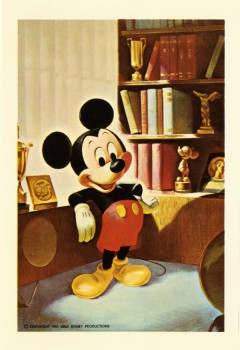 Earle, Joshua Meador, Marc Davis and others received my kid fan mail. Maybe once every four or five months I’d send off another letter.
Earle, Joshua Meador, Marc Davis and others received my kid fan mail. Maybe once every four or five months I’d send off another letter.
I started getting postcards back from what I presume was the mailroom at the studio. Just as Lana Turner would have sent back an 8×10 glossy with a signature by someone, the Disney studio sent out postcards.
Somehow, none of these were saved. I recently found one such card on ebay and sucked it for memorabilia’s sake. This card, to the left, is smaller than the ones originally sent out, but the picture’s the same. I remember one which was very different. It must have had fifty characters in it – a lot of the feature characters (somehow I remember Brer Rabbit) – were set within drawn frames and gathered on this card. That’s right, about fifty frames on a little card – maybe 5×7 – so all the characters were small. Just right for a kid’s small hands.
.
(Click on images to enlarge.)
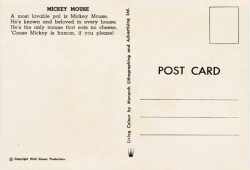 There was always some innocuous writing on the back of the card. “Best wishes from Walt Disney,” or some such phrase. After the first card, I lost interest in the printed signature. Anyway, I had sent my letter to Ward Kimball; why did Disney sign it!
There was always some innocuous writing on the back of the card. “Best wishes from Walt Disney,” or some such phrase. After the first card, I lost interest in the printed signature. Anyway, I had sent my letter to Ward Kimball; why did Disney sign it!
My favorite return was something I’d gotten from a letter sent to Joshua Meador.
Aside from the postcard there was a xerox copy of an article written in 1933. “The History of the Animated Cartoon” by Earl Thieson was written for the journal of the Society of Motion Picture Engineers. A nicely printed copy of the article was sent to me anonymously. It took a while to see that the document was written so early and excluded 2/3 of the history of animation that I knew. It made me feel that my one fan letter had hit home and was read by someone other than the studio gate guard.
- Yesterday, the New York Times featured an article about comic strip collectors and shows how some individuals are helping to save a medium that is in danger of dying. Gasoline Alley serves as the example of strips that are kept alive by these fans. You can purchase volumes of Gasoline Alley from Drawn and Quarterly or Amazon.
Animation Artifacts 10 Jan 2007 08:20 am
Disney Bulletin
- For all the Fantasia historians out there, I’m posting the Disney Bulletin special edition for the initial release of the film.
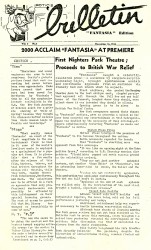 The Bulletin, of course, was the in-house news organ for the studio. They give you entertaining information such as the weather that greeted the opening of Fantasia in New York City. (Scattered rains stopped just prior to the first screening and clear skies were predicted for the entire first week.)
The Bulletin, of course, was the in-house news organ for the studio. They give you entertaining information such as the weather that greeted the opening of Fantasia in New York City. (Scattered rains stopped just prior to the first screening and clear skies were predicted for the entire first week.)
You also get an answer to the question, “What’s a Fishinger?” on pg 2.
Then, there’s the grid iron picks of cameraman, Dick Blundell.
There’s a lot of amusement in here and a lot of information. We can’t really understand the history of animation without understanding the times the people were living through.
That’s the most pertinent part of the publication.
(Click any image to enlarge.)
The inimitable Hans Perk has posted on his site three homework assignments from the Layout Training Courses given at the Disney Studios during the Thirties. Hans links to the full lectures/courses he and I put up on our sites and suggests it’s valuable to actually do the assignments prior to reading the courses. And he’s right. I did these years ago, on my own, when I worked at the Hubley Studio and found my own understanding of Layout acutely altered by the lessons. (It was during this period that John Hubley actually was surprised by something I did on Everybody Rides The Carousel – something right out of the course – and he complimented me. A rarity for John.)
Thanks, Hans, for keeping these lessons alive. His site has become a vital part of my daily blog reading.
We’re only ten days into the New Year, and already three members of the animation community have died.
HELEN HILL
It’s getting difficult to look at the inestimably valuable Cartoon Brew for the bad news.
- As a follow up, I suggest everyone read Tom Sito‘s beautifully written obituary for Iwao Takamoto on his site yesterday.
- The NY Times posted their obituary for the artist today .
Animation Artifacts &Commentary &Daily post 09 Jan 2007 08:08 am
Terry Bent
- I’m a fan of Terrytoon cartoons. Yes, it’s a guilty pleasure. I don’t like them just for the Jim Tyer animation – but, of course, I do love the Jim Tyer animation.
I recognize how poor they are, compared to the other films being produced at the time (but they’re arguably better than most animation being produced today.) But there’s something about that Phil Schieb music that gets me. Or to hear some of those sound effects; the ploppy splashes of water on the sound effects brings it all back.
What a pleasure, then, to see the recent posts on the Hollywood Animation Archive Blog. There are the model sheets posted now. They’re attached to an appreciation of the film, The Tempermental Lion, which is also posted.
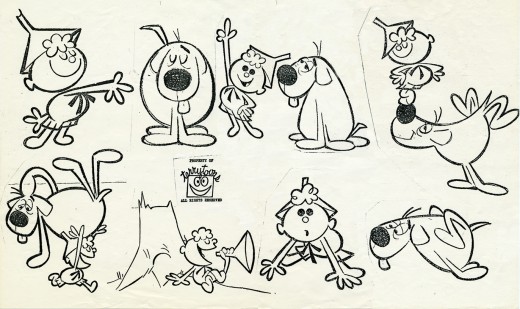 (Click either image to enlarge.)
(Click either image to enlarge.)
The same site features the Nat Falk book, How To Make Animated Cartoons post #1 and post #2. This is a Terry-centric book written in 1941 with a foreward by Paul Terry.
I have another Nat Falk book in my collection which is, unfortunately, currently in storage. Eventually, I’ll post it when I can get it out.
In the meantime, posted are a Mighty Mouse and a Tom Terrific model sheet, neither of which appeared on their site.
There was a time in my childhood when I was addicted to Mighty Mouse. I drew the character everywhere, all the time. All of my schoolbooks became flipbooks of Mighty Mouse. It was obsessive for a while – though I don’t think anyone noticed but me.
 The NYTimes, today, has an article about James Cameron‘s next film. It’s expensive, of course, and will use cgi characters as no one has done in the past. Apparently, MoCap actors will be combined with real actors, and it seems they’ll be shot at the same time.
The NYTimes, today, has an article about James Cameron‘s next film. It’s expensive, of course, and will use cgi characters as no one has done in the past. Apparently, MoCap actors will be combined with real actors, and it seems they’ll be shot at the same time.
-
“For its aliens, “Avatar†will present characters designed on the computer, but played by human actors. Their bodies will be filmed using the latest evolution of motion-capture technology — markers placed on the actor and tracked by a camera — while the facial expressions will be tracked by tiny cameras on headsets that will record their performances to insert them into a virtual world.”
“The most important innovation thus far has been a camera, designed by Mr. Cameron and his computer experts, that allows the director to observe the performances of the actors-as-aliens, in the film’s virtual environment, as it happens.”
Now MoCap will not only replace animators but live actors as well. Good luck.
The NYTimes today also has a review by Dave Kehr of the 4 additions to the Disney Treasures series of DVD’s. All praise Leonard Maltin.
- “The Complete Pluto, Volume Two†takes Mickey’s oddly disadvantaged animal companion (why is Pluto the only resident of Disneyland who isn’t able to speak?) from 1947 to 1951, and represents Disney product at its least distinguished, most industrial level.
Far more intriguing are “Your Host, Walt Disney†— five episodes from Disney’s weekly television show, all with Uncle Walt — and, supremely, “More Silly Symphonies, Volume Two,†a gathering of work from 1929 to 1938, most of it very seldom seen.
Animation Artifacts 02 Jan 2007 08:32 am
Prescott Wright 1931-2006
Last night, Charlie Rose aired an appreciation of a number of his past guests who had died in 2006. R.W. Apple, Stanley Kunitz, Milton Friedman and others were given a short clip of about a minute each from past shows. It made for a sad but interesting hour.
Prescott Wright died last Thursday. I had hoped to post something a bit sooner but decided to wait for the tribute written by Karl Cohen of ASIFA-SF sent to me Sunday:
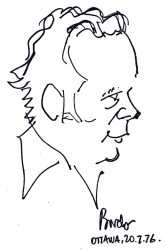 PRESCOTT WRIGHT, THE PRODUCER OF THE TOURNEE OF ANIMATION FOR MANY YEARS, A FOUNDER OF THE OTTAWA INTERNATIONAL ANIMATION FESTIVAL AND ASIFA-SF AND A GREAT FRIEND OF ANIMATION, PASSED AWAY ON DECEMBER 28. Prescott had been in slow decline for several years with Picks Disease, a form of dementia related to Alzheimer’s. He was living in Albuquerque, New Mexico and was 71.
PRESCOTT WRIGHT, THE PRODUCER OF THE TOURNEE OF ANIMATION FOR MANY YEARS, A FOUNDER OF THE OTTAWA INTERNATIONAL ANIMATION FESTIVAL AND ASIFA-SF AND A GREAT FRIEND OF ANIMATION, PASSED AWAY ON DECEMBER 28. Prescott had been in slow decline for several years with Picks Disease, a form of dementia related to Alzheimer’s. He was living in Albuquerque, New Mexico and was 71.
Prescott was raised in the Bronx, was stationed in the Army at Ft. Ord and went to Monterey Community College. In the mid-1960s he moved to San Francisco where he worked at Brandon Films and then moved to Los Angeles to study film at the American Film Institute. He returned to San Francisco about 1970 to work on a graduate degree in film at San Francisco State University (MA 1975). While at State he was asked to be a teaching assistant and then a part-time instructor. He also worked again at Audio-Brandon and was running Filmwright, his own small film distribution company as a part-time business.
While working with Brandon Films, a major film distributor of American and foreign features and shorts; he developed a keen interest in animation from around the world. In the late 1960s several of his friends with ASIFA-Hollywood (Bill Scott, Bill Littlejohn, Les Goldman and June Foray) decided to put together an international animation program to be shown at the Los Angeles County Museum of Art. It was almost impossible to see quality animation in the US at that time. Pres was active with the group and having worked previously in film distribution, he was asked to head the project when they decided to show the program in other places (ca. 1969). Under his guidance the program became known as the International Tournee of Animation and he began to book the program at the San Francisco Museum of Art and other cultural institutions around this 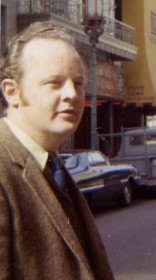 country. He continued to organize and distribute the annual celebration until Expanded Cinema purchased rights to the program in the late 1980s.
country. He continued to organize and distribute the annual celebration until Expanded Cinema purchased rights to the program in the late 1980s.
For many years Prescott was on ASIFA’s International Board of Directors (ASIFA is the international animation association with over 30 chapters around the world.). Until the Iron Curtain fell ASIFA helped bridge the gap between East and West by helping animators from Eastern Europe attend festivals in the West, to visit studios in the Europe and North America and to show their films in-person. Pres, David Ehrlich, Howard Beckerman, Charles Samu, John Halas, John Hubley and others worked hard to further international relations and to arrange for these screenings in cities with ASIFA chapters. He was also a founder of ASIFA-San Francisco chapter, a very active and creative group.
Prescott also served as an advisor to major animation festivals around the world. He was a founder and the first International Director of the Ottawa International Animation Festival (1976) and also served in that capacity in ’78, ’80, ’82, and in 1992. In 2004 the Ottawa festival made him an honorary president of the festival, but he was unable to attend the event. He also served a year as director of the Denver International Film Festival (1981/82), helped start a festival at Foothill College and was involved with several other cultural events.
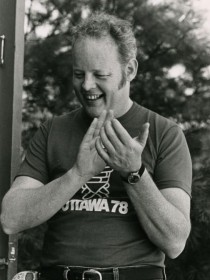 In the 1990s he worked for a year for Disney as a spotter and recruiter of animation talent. After that he worked in both the Philippines and Southern India as an instructor and festival director for emerging animation studios.
In the 1990s he worked for a year for Disney as a spotter and recruiter of animation talent. After that he worked in both the Philippines and Southern India as an instructor and festival director for emerging animation studios.
In the 1970s Gary Meyer who ran the U.C. Theater in Berkeley and became a co-founder Landmark Theatres, convinced Prescott to expand his distribution of the Tournee of Animation to theaters. Gary says, “We needed interesting new programming and approached Prescott about showing the Tournee in theaters. He had only screened at colleges and museums. He took the leap with us and the result was a greatly expanded audience for animated shorts. At a certain point he got burned out. Assembling a feature length package, distributing it and keeping a couple dozen filmmakers happy is an overwhelming task. We agreed to buy the Tournee with the understanding that Prescott would continue to provide guidance as we moved forward. And what a mentor he was!â€
Author and animation historian Jerry Beck writes, “I met Prescott shortly after I moved to L.A. in 1986, when I came to work with Terry Thoren to distribute the Tournee for Expanded Entertainment. Prescott was always friendly, knowledgeable and eager to help us communicate with filmmakers and theatre owners across the country and around the world. Prescott was a pioneer – in those pre-cable, pre-Internet days – in getting independent and international animation showcased and making those films accessible to those unable to attend festivals in far off lands. Without Wright’s vision, the Ottawa festival would not be what it is; successor-touring programs like Spike and Mike and The Animation Show would not be and ASIFA-SF would not be the strong chapter it is.â€
Prescott ‘s daughter Maureen Wright, her family, and his brother Roger Wright from Florida and a few friends will have a small ceremony in his honor in Santa Fe, New Mexico in the first week of January. His ashes will be buried with full military honors at the Santa Fe National Cemetery (date to be confirmed). The Aspen Funeral Alternatives in Albuquerque is handling the arrangements (505-323-9000).
ASIFA-San Francisco will dedicate some time at their Friday, Jan. 5 ASIFA 12th Night Party to honor his memory and invites those of who knew him or were inspired by his programs to send their newsletter a memory of him to share with others for the February newsletter and on their website. karlcohen@earthlink.net
(All images enlarge by clicking.).
Images above are:
1. A caricature of Prescott Wright by Zagreb’s own Borivoj Dovnikovi.
2. Prescott in 1971.
3. Prescott in Ottawa 1978.
Animation Artifacts 01 Jan 2007 08:02 am
Happy New Year
- I’d posted this image once before. I love it.
When I bought it, the drawing was sold as one from The Three Little Pigs (1933). However, I wasn’t completely convinced and went searching. The image actually comes from The Big Bad Wolf (1934) as the wolf jumps into Grandma’s house.
I’m not disappointed since I love this pose so much, and there’s nothing quite like it in The Three Little Pigs. (Though I do like the original’s one suspender rather than the two here.) Of course, a drawing of the wolf as the Jewish peddler would be priceless.
I can’t think of a better image to start off the New Year.
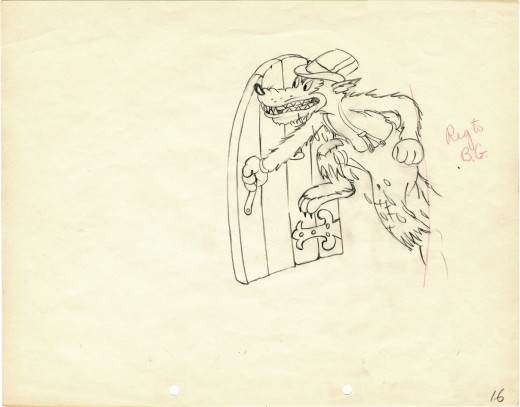
(Click on any image to enlarge.)
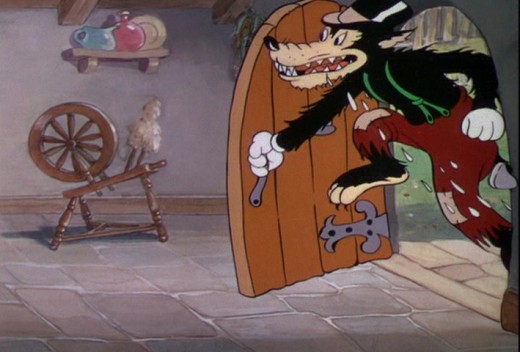
A frame grab from The Big Bad Wolf.
Animation Artifacts 29 Dec 2006 07:57 am
Mickey’s Good Deed
- Hans Perk followed up my coments on Mickey’s Good Deed with the breakdown drafts for the film. I like seeing the visual breakdowns that Mark Mayerson has been doing off these drafts. Since I suspect this is not a film Mark would break down, I decided to do it. I thought it a good way to study some of the animation (drawn a bit crudely, but well timed), so it was fun doing it. Thanks Hans for the drafts, and thanks Mark for the format.
The animators here include: Johnny Cannon, Ben Sharpsteen, Les Clark, Frenchy de Trémaudan, Tom Palmer, Hardie Gramatky, Dick Lundy, Gerry Geronimi, and the last scene is by Norm Ferguson. As Hans points out, Ben Sharpsteen covers a lot of scenes. Since he’s the film’s director it probably means he’s supervising some younger animators.
(note: Hardie Gramatky is the same guy who wrote and illustrated the famous book, Little Toot, which eventually became a Disney short.)
(Click on any of the images below to enlarge.)
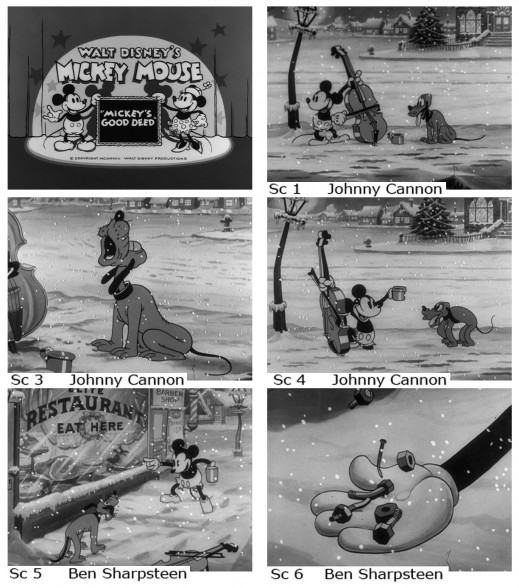 1
1
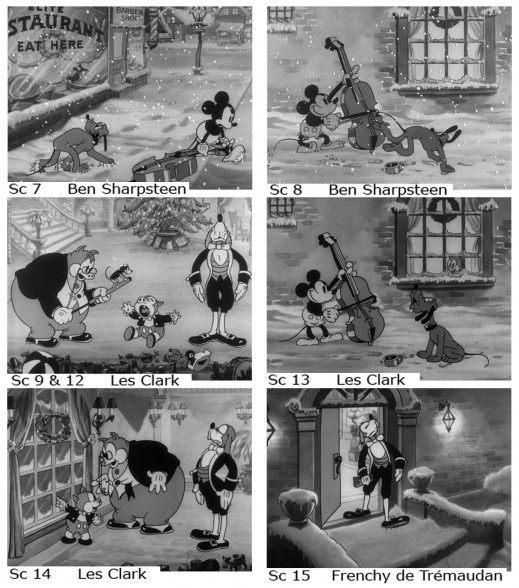 2
2
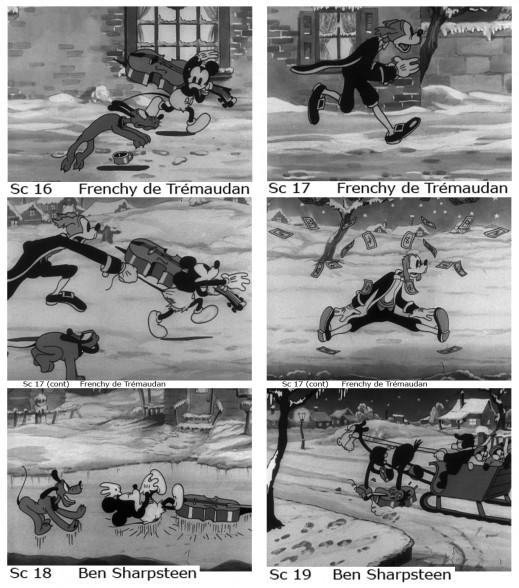 3
3
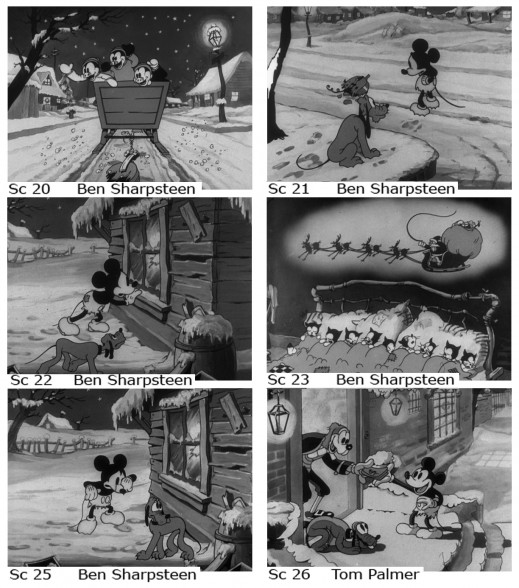 4
4
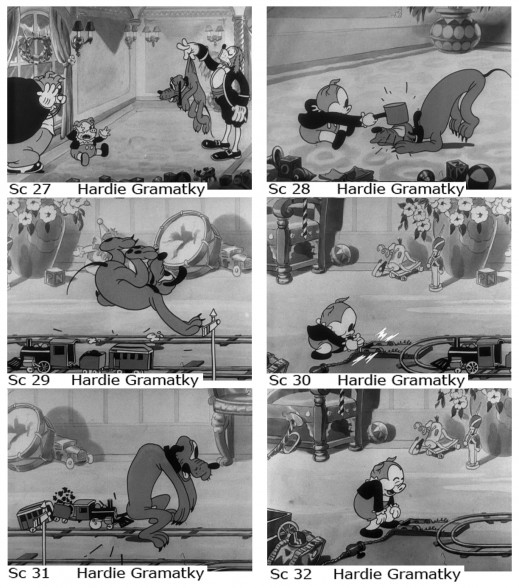 5
5
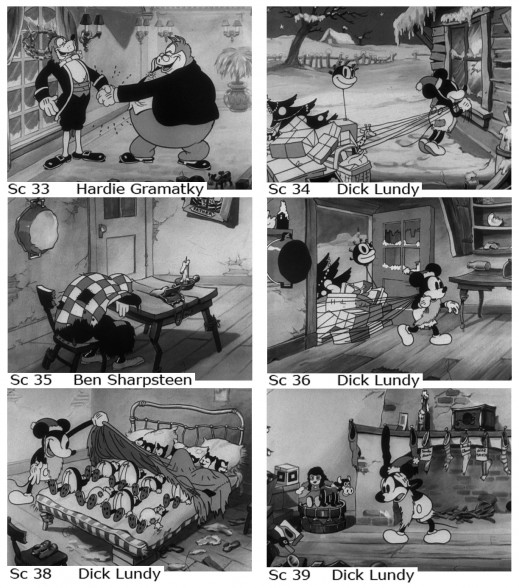 6
6
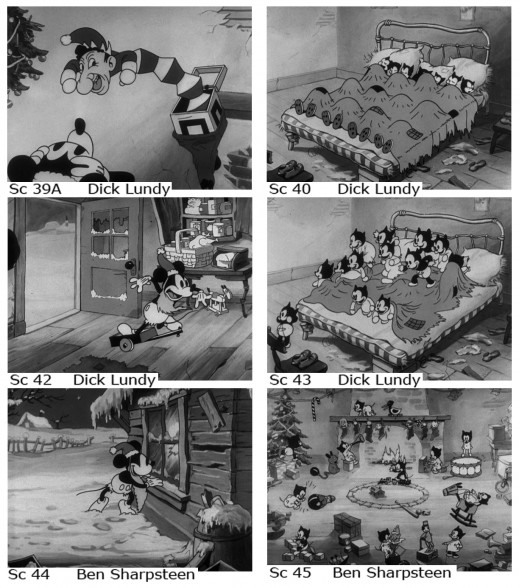 7
7
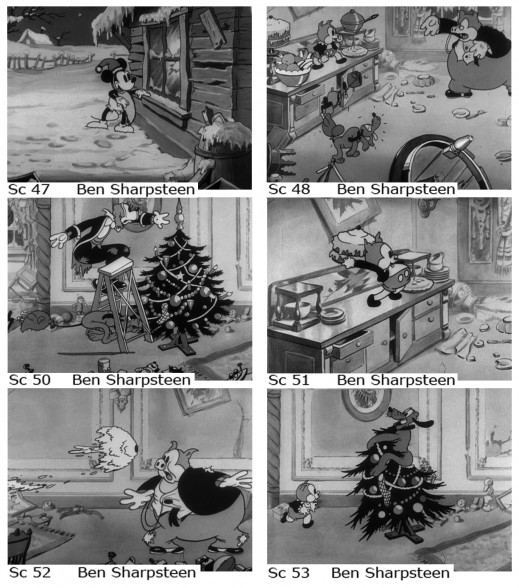 8
8
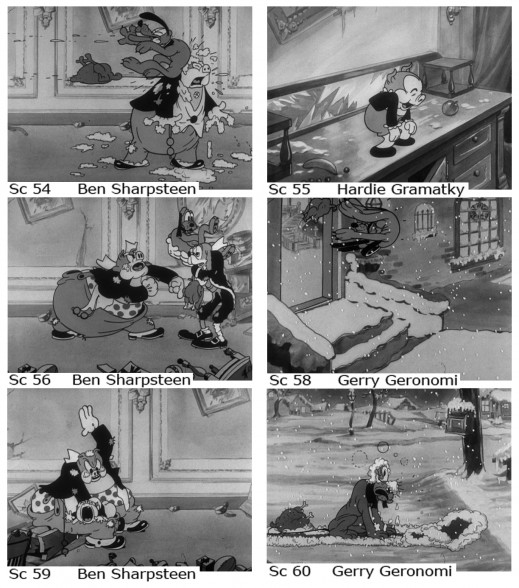 9
9
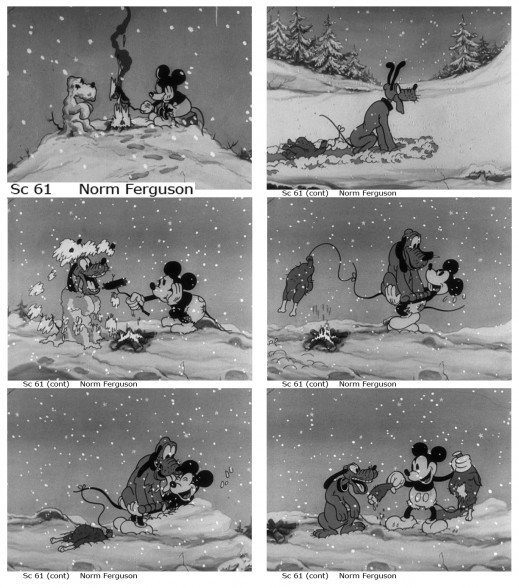 10
10
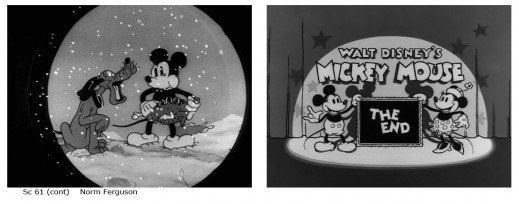 11
11
Animation Artifacts &Daily post 27 Dec 2006 08:38 am
Tytla and the Best
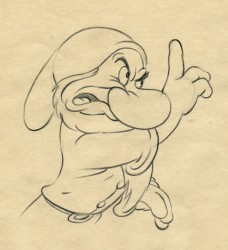 – In 1994 John Canemaker organized an exhibit for the Katonah Museum of Art. It showcased in great detail the work of animation’s, Bill Tytla. The Hollywood Animation Archive Blog now posts the catalog for that show in the first of two parts.
– In 1994 John Canemaker organized an exhibit for the Katonah Museum of Art. It showcased in great detail the work of animation’s, Bill Tytla. The Hollywood Animation Archive Blog now posts the catalog for that show in the first of two parts.
I remember the show as quite remarkable. Any enormous respect I had had for Bill Tytla’s work was magnified exponetially.
Viewing the catalog again reminds me of the fabulous work that John Canemaker had done in organizing the show. Thanks, yet again, to the work of Stephen Worth in making this available at the site.
A Tytla drawing from my collection.
(click on image to enlarge.)
- This list of the Best Children’s films of 2006 includes my film, The Man Who Walked Between The Towers, and the feature Monster House as the only two animated films on their list of “bests.”
To show how ridiculous this list from Scripps Howard News Service is, the new dvd of Dumbo is on their “worst” of 2006 list. They describe one of my favorite Disney features as, “a relic, with a number of racist and stereotyped characters and overwrought emotion.”
The scene Tytla animated of Dumbo playing in the legs of his mother is, in my opinion, one of the best scenes ever animated. Every child should be made to watch this scene and this film. John Canemaker’s commentary for the dvd is, as I’ve said several times on this blog, one of my favorites. It’s the premiere example, to me, of what all commentary tracks should be.
- For those who haven’t yet seen it, David Nethery has posted on his site a 1966 Christmas Bumper R.O. Blechman did for CBS. It’s a beautiful, music card of a piece that shows all the poetry Blechman got into his films. Ed Smith animated this rich, short film.
- Finally, today, I’d like to quote a paragraph from Michael Musto‘s lookback-at-2006 column in today’s Village Voice. He reviews most of the animated features, and I thought it amusing:
-
We pause now for a brief rant: Much as I adore animated films, the plethora of them
that came out this year with inspiring messages about how critters (or vehicles) are
good and people are bad made me feel their ka-chinging creators should be forced
to live by their own patronizing idealism or die. Cars should have been dumped onto
DVD with no hoopla whatsoever (it’s more important to be a good soul than to
succeed, remember?); the Ant Bully people should find their houses infested with
bugs and then be made to join them to learn the importance of community; and the
Barnyard bunch, who preached that responsibility is superior to having a messy good time, should never be allowed to make another movie. Otherwise we’re destroying
our children with hypocrisy and lies!
But how dare anyone suggest that: Happy Feet ripped off March of the Penguins:
It ripped off Billy Elliot!
Animation Artifacts &Commentary &Daily post 26 Dec 2006 08:37 am
Barbera+Culhane+Sanders
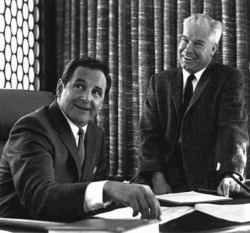 – On Google video you can see a seven part interview with Joe Barbera done in 1977 for the TV Academy.
– On Google video you can see a seven part interview with Joe Barbera done in 1977 for the TV Academy.
Leonard Maltin starts the interview, parts 1-4.
Sunny Perish (?) concludes parts 5-7.
Part 1. Here
Part 2. Here
Part 3. Here
Part 4. Here
Part 5. Here
Part 6. Here
Part 7. Here
There’s an accurate commentary of Barbera’s career on Harry McCracken‘s site. This is followed by an even darker comment by Mark Mayerson and a defense of Barbera by Thad Komorowski.
I have to say that when Barbera died I had no feeling whatsoever. I still don’t. That last Tom & Jerry which has his name attached was as horrendous as anything he’s done since the second year of The Flintstones.
I saw few Tom & Jerry’s growing up in New York. In theaters, we were always treated to Terrytoon, Paramount and infrequent Disney shorts. I don’t think I saw a Tom & Jerry projected until I went to animation programs at MOMA. Finally, in my college years all those Tom & Jerry shorts were thrown into syndication, and they ran in NY on channel 11, a station once owned by The NY Daily News, at 5:30pm.
I had to rush home from school nightly to see these programs – 3 shorts each. After weeks of viewing, I was blown away. My initial reaction was that I had spent 17 years trying to see any and every piece of animation and had found this trove of fully animated shorts – lots of lives spent – on films that I hadn’t seen. If there were that many films that I hadn’t seen, what did that say about the work of so many other animators whose work lived in limbo?
My second reaction was horror. These films were violent to the point of horrific. The animation was superb, the music was brilliant, but the violence was upsetting. These are the only cartoons ever to have caused me to flinch. Seeing – I think it was – the Oscar winning, The Two Mouseketeers where Jerry runs the course of a table past a turkey that has a knife sticking out of its side – which lies just over his head. Tom pursues. He’s taller. The violence takes place off screen (as H&B did for years to save animation). Tom is cut and I flinched. I didn’t like that and still don’t. Another cartoon had an axe cut off Tom’s tail. It hurt. The characters I never cozied up to were being mangled by their creators. Not like the funny stuff that was going on at WB; it was different here. The directors hurt them, and then hurt them some more.
After MGM, H&B opened. Even before those Tom & Jerry shorts made it to TV, RUff & Reddy, Huck Hound, Yogi and The Flintstones brought new style to limited animation TV. I enjoyed it as a kid (in B&W), and I even felt I could guess-count the drawings in a scene. Timing was good and the design was excellent. The Hoyt Curtain music wasn’t my favorite – it seemed to be playing without regard to what was on screen, but still, I liked these shorts.
Then came the rest. With Johnny Quest I started not liking H&B. I didn’t like Scooby Doo or so many of the rest of the titles I couldn’t name for you. The mechanics were always showing, but now there was no string of good design, good timing, good anything to hold it together. Crap was what H&B produced. That crap provided a lot of jobs – even more to Asia, but it was not good film making.
Their first feature, “Hey There, It’s Yogi Bear,” was ridiculous. I thought that I even saw the edge of a pan cel move through a scene. Colors popped, animation was mediocre at best, and the story was tedious. It didn’t get better with “Charlotte’s Web” or “Heidi.”
So now, Hanna and Barbera have died. Their studio died when Turner bought them out and Cartoon Network rolled over them. After MGM, they made some interesting shorts that was about quantity not quality. They were the type of animators more interested in the dollars they could bring home than the films they were making. I don’t blame them for it, but I can’t glorify their work either. They were who they were, and I give them credit for the long and elaborate careers they had.
 – Last Sunday, there was a NY Times review of Neal Gabler’s Disney book.
– Last Sunday, there was a NY Times review of Neal Gabler’s Disney book.
The review as well as Gabler’s book seems to have riled some people, and John Culhane responded with a letter that was printed in this past Sunday’s NY Times.
.
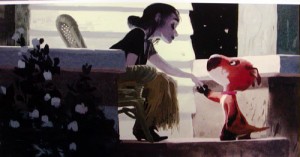 - Chuck Oberleitner has a detailed commentary here on the ousting of Chris Sanders and his American Dog project from Disney’s animation department.
- Chuck Oberleitner has a detailed commentary here on the ousting of Chris Sanders and his American Dog project from Disney’s animation department.
The article comes off as quite accurate without painting villains the way we animators are want to do. Of course, there’s no way any of us will really know what the truth is, and it almost doesn’t matter at this point. Animation history moves on. Maybe Chris Sanders will return to 2D animation; Lilo & Stitch was the last decent film from the Disney (non-Pixar) studio.
